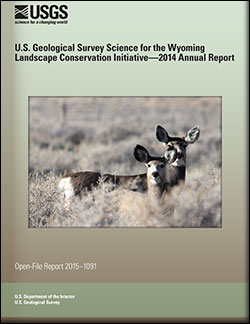|
|

Ongoing energy development in the northern Green River structural basin necessitates information about groundwater resources that supply water to the basin’s wells. Many human activities in that area, including pumping water from the aquifers for agricultural, domestic, and industrial use, and penetration of the heterogeneous (that is, complex intertonguing of layers) aquifers (see Bartos and others, 2015) during deeper drilling for natural gas, have the potential to impact the aquifer system that supplies water to most wells in the area. We initiated this study in FY2012 as “A Retrospective Assessment of Groundwater Occurrence in the Normally Pressured Lance Formation and a Field Reconnaissance of Existing Water...
|

This is the seventh report produced by the U.S. Geological Survey (USGS) for the Wyoming Landscape Conservation Initiative (WLCI) to detail annual activities conducted by the USGS for addressing specific management needs identified by WLCI partners. In FY2014, there were 26 projects, including a new one that was completed, two others that were also completed, and several that entered new phases or directions. The 26 projects fall into several categories: (1) synthesizing and analyzing existing data to identify current conditions on the landscape and using the data to develop models for projecting past and future landscape conditions; (2) monitoring indicators of ecosystem conditions and the effectiveness of on-the-ground...
|

Riparian and aquatic ecosystems in semiarid landscapes like Southwest Wyoming contribute significantly to regional biodiversity. Long-term monitoring data that describe streamflow, surface-water quality, and groundwater levels are needed for assessing possible effects of changes in land use, land cover, and climate on those ecosystems. With WLCI funding, surface-water quality has been monitored at four sites, and groundwater levels have been monitored at one site. The monitoring sites were selected to provide baseline characterization of the upper Green River Basin and the Muddy Creek watershed. All data are collected according to USGS methods (Wagner and others, 2006; Kenney, 2010; Sauer and Turnipseed, 2010; Turnipseed...
|

A machine learning streamflow (MLFLOW) model was developed in R (model is in the Rscripts folder) for modeling monthly streamflow from 2012 to 2017 in three watersheds on the Wyoming Range in the upper Green River basin. Geospatial information for 125 site features (vector data are in the Sites.shp file) and discrete streamflow observation data and environmental predictor data were used in fitting the MLFLOW model and predicting with the fitted model. Tabular calibration and validation data are in the Model_Fitting_Site_Data.csv file, totaling 971 discrete observations and predictions of monthly streamflow. Geospatial information for 17,518 stream grid cells (raster data are in the Streams.tif file) and environmental...
Types: Map Service,
OGC WFS Layer,
OGC WMS Layer,
OGC WMS Service;
Tags: Ecology,
Geography,
Hydrology,
USGS Science Data Catalog (SDC),
Upper Green, All tags...
Wyoming,
Wyoming Landscape Conservation Initiative,
environment,
geoscientificInformation,
geospatial analysis,
geospatial datasets,
hydrology,
machine learning,
mathematical modeling,
multivariate statistical analysis,
river reaches,
river systems,
streamflow, Fewer tags
|
|